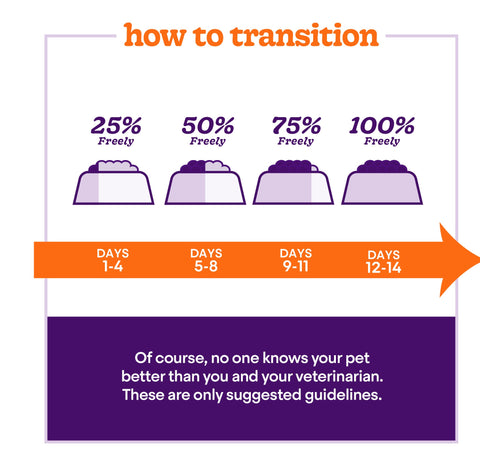Many people want variety in the food they eat and feel the same holds true for their pets. At Freely, we embrace and applaud change but know it's easy to feel overwhelmed by the idea of switching your pet from one food to another. We had this in mind when creating our recipes which is why all Freely foods share a common base set of ingredients with different proteins. With Freely, you can easily and confidently add variety to your pet’s diet. Let’s talk a little bit about the whys and hows of transitioning foods to help make it easier on you and your pet.
Why might you transition?
Sometimes, switching up your pet’s food can make mealtime more exciting. Often, we like to give our pets the same variety we crave through different foods, treats, chews, and so on. Other times, there’s a more compelling reason to switch, such as a new food sensitivity. It’s also possible your pet might not be doing as well as you’d hope on their current diet. No matter what reason you have for switching up your pet’s food, it’s important to transition them slowly to their new diet.
Why should you transition slowly?
The food your pet eats impacts what happens in their intestinal tract, more commonly called the gut. There are actually beneficial bacteria in your pet’s gut that need food as much as your pet does. When big changes happen in your pet’s food regimen, these bacteria need time to adapt. If you try to change too fast, the bacteria can’t adjust quickly which can lead to softer stools or maybe even diarrhea. This switch can be hard on your pet’s gut in the same way eating food you’re not used to can lead to an upset stomach or other digestive issues. Transitioning your pet’s food slowly is important to give the microorganisms inside your pet’s gut a chance to acclimate to the new diet.
In addition to keeping your pet’s gut bacteria healthy, switching slowly can be critical for discerning pets. Some pets may have a strong preference for one texture or flavor of food. Gradually transitioning their food is important so they don’t become overwhelmed and stop eating altogether. These pets often need a long and slow transition period as they become used to their new cuisine.
Ok, so how do you transition?
The general idea is to slowly decrease the amount of your pet’s current food while increasing the amount of the new food you wish to use. For both cats and dogs, we typically recommend taking about 7-14 days to gradually transition to the new food. Every pet is different though, and some may require more time than others. As always, you and your vet know your pet best and should decide if this traditional approach to food transitioning is the right path.
Introducing a topper, such as a broth, to your pet’s diet for the first time is a little simpler. We recommend you try a tiny bit on top or mixed into your pet's regular food. If they tolerate this well, you can increase the amount gradually. Wait a day to see how their whole body (not just their tongues!) process the change and then add more over time. If the addition of a topper is successful, we recommend you decrease the amount of their other food appropriately to help your pet achieve their nutritional goals.
As you add new things to a complete and balanced diet, it’s always good to observe what your pet does. Do they gulp it down? Do they chew the food well? Do they sniff the food and back away? These observations will help you decide if the transition to the new food is going well.

Still have questions?
Our pet nutrition team is here for you. Send us an email, give us a call, or connect with us through LiveChat. We’d love to talk through your pet’s unique nutritional needs!

